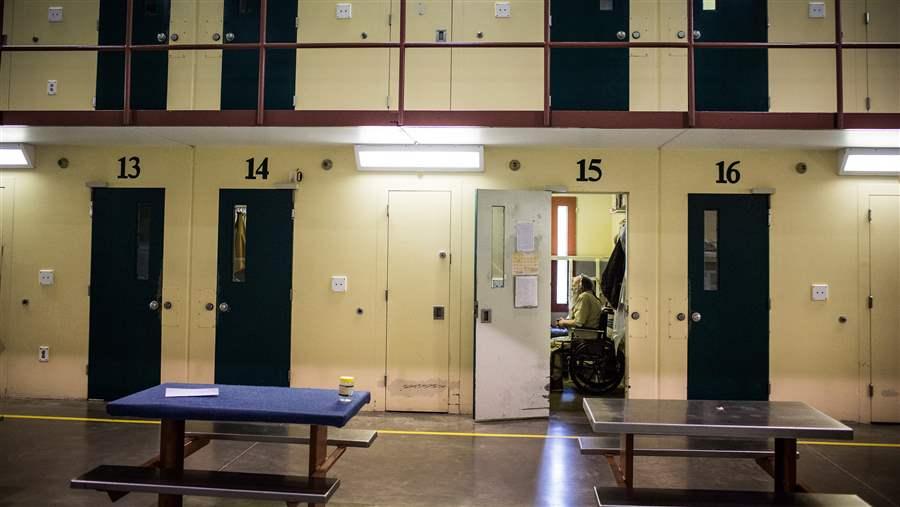Prison Health Care Costs and Quality
How and why states strive for high-performing systems
This report was updated on Dec. 8, 2017, to clarify state variation in the number of health professional employees for every 1,000 inmates in custody.
This report was updated on Oct. 30, 2017, to reflect revised data submitted by the Mississippi Department of Corrections pertaining to Medicaid enrollment.
On Oct. 27, 2017, the New Mexico Corrections Department (NMCD) reported to Pew researchers that its per-inmate health care spending figures in this report are inaccurate, reflecting incorrect information provided earlier by department officials. Pew has asked the state to supply in writing revised data and guidance; once these are submitted, Pew will amend or update the report as necessary. Questions related to these data should be directed to NMCD.
Overview
Prison health care sits at the intersection of pressing state priorities. From protecting public safety to fighting disease and promoting physical and behavioral health, and from fine-tuning budgets that trim waste to investing in cost-effective programming with long-term payoffs, the health care that prisons provide to incarcerated individuals and the care that prisons facilitate post-release is a critical linchpin with far-reaching implications.
On a typical day, state prisons house more than a million people, many of whom have extensive and communicable health ailments. The manner in which services are provided affects state budgets because of the expensive treatments for some common conditions, the downstream costs of delayed or inadequate care, and the legal and financial consequences of being found to violate inmates’ constitutional rights to “reasonably adequate” care. Moreover, with nearly all incarcerated individuals eventually returning to society, treatment and discharge planning—especially for those with a substance use disorder, mental illness, or infectious disease—play an important role in statewide anti-recidivism and public health efforts. Taken together, these realities call for the attention of policymakers and administrators.
Yet these officials often lack the information they require to build and maintain high-performing prison health care systems that proactively make the most of diagnostic and treatment opportunities and avert the harmful and expensive consequences of inattention or missteps. They need to know how much money is being spent on what services and why; what benefits are achieved for those dollars; and whether these benefits are preserved post-prison through well-coordinated prison-to-community transitions.
This first-of-its-kind report, using data collected from two 50-state surveys administered by The Pew Charitable Trusts and the Vera Institute of Justice, along with interviews with more than 75 state officials, updates previous Pew research on spending trends in prison health care. The report also incorporates information on the operational characteristics of states’ prison health care systems; whether and how states monitor the quality of care provided— the critical counterpart to cost when assessing value; and common care continuity strategies for people leaving prison. The aim is to begin to paint a comprehensive picture for policymakers, administrators, and other stakeholders of how states fund and deliver prison health care, how they compare with one another, and some reasons for differences. These stakeholders can use such practical information and insights to help optimize policies and programs in the service of incarcerated individuals, state residents, and taxpayers.
The first of the two surveys,for which every state except New Hampshire provided data, queried senior budget staff of state departments of correction on expenditures, prison population demographics, the health care delivery system employed, and staffing. The second survey, for which every state except Alabama, Kansas, and New Hampshire provided data, collected information from senior health care staff of departments of correction on efforts to monitor the quality of care provided, disease prevalence tracking, and services to facilitate care continuity at release.
Notes: The 49-state median excludes New Hampshire, which did not provide data.
Nominal spending data for fiscal 2010–15 were converted to 2015 dollars using the Implicit Price Deflator for Gross Domestic Product included in the Bureau of Economic Analysis’ National Income and Product Accounts.
North Dakota did not report spending data for fiscal year 2010.
In Louisiana, beginning in fiscal 2014, off-site medical costs were included in the Department of Correction’s budget, rather than Louisiana State University’s. This shift resulted in a $20 million (44 percent) increase in health care spending by the department from fiscal 2013 to fiscal 2014 and contributed to the department’s reported per-inmate health care spending increase from fiscal 2010 to fiscal 2015.
(See Appendix C, Table C.3 for state data.)
Pew’s research found:
- Departments of correction collectively spent $8.1 billion on prison health care services for incarcerated individuals in fiscal year 2015—probably about a fifth of overall prison expenditures.
- Health care spending per inmate varied dramatically in fiscal 2015, as it had in past years—from $2,173 in Louisiana to $19,796 in California. State officials across the country need to understand whether and how these differences reflect meaningful discrepancies in value and performance. This knowledge helps states determine if their prison health care systems assist or undermine their efforts to achieve universal goals: meeting constitutional obligations, protecting public safety, strengthening public health, and practicing fiscal prudence.
- Knowing how money is spent, and how the spending distribution has changed over time, is critical to understanding interstate spending variation and evaluating cost-effectiveness. But with few exceptions, state data systems preclude detailed, actionable analysis. Reporting limitations were most common among states that primarily or wholly outsource their prison health care delivery.
- States reported dramatically different approaches to staffing by departments of correction and their vendor and university partners in fiscal 2015. Not surprisingly, staffing levels appear to correlate with per-inmate prison health care expenditures: Median per-inmate spending was more than double among the 10 states with the highest staffing levels than among the 10 states with the lowest levels.
- Along with how money is spent, knowing whom it is spent on is important to understanding costs. Treating chronic conditions has emerged as a growing challenge and expense in state prisons, exacerbated by an aging prison population. From fiscal 2010 to 2015, the share of older individuals in prison rose in all 44 states that submitted prisoner age data to Pew and Vera.
- The quality of care that prisons provide has a major impact on their contribution to the achievement of state goals. Assessing the value that taxpayers get for their prison health care dollars—that is, whether desired outcomes are achieved at sustainable costs—and how that value compares with other states requires quality measurement and monitoring. Thirty-five states reported that they operated a prison health care quality monitoring system in fiscal 2016. These systems took different shapes but shared four key characteristics: They were grounded in data; established and overseen by state agencies; applied broadly and consistently across facilities; and operated on an ongoing basis. However, of these 35 states, only Florida, Nebraska, Nevada, New Jersey, New York, and Texas indicated that they take additional steps to formally require quality monitoring and build in regular opportunities to incorporate the findings into decision-making and legislative oversight, which can clarify priorities, bolster consistency amid personnel changes, and help ensure that objectives are met.
- Respondents from all except four of the 12 states without a quality monitoring system agreed or strongly agreed that establishing such a system is necessary to achieve at least an adequate level of quality. A majority also agreed or strongly agreed that this step would improve the quality of care provided in their system as well as their state’s understanding of the value of its prison health care spending.
- State departments of correction increasingly recognize the benefits and importance of facilitating care continuity for individuals returning to the community. These departments take a variety of steps, often in partnership with other state agencies, to smooth re-entry from a health care standpoint and preserve positive outcomes from in-prison investments. These efforts include helping individuals acquire health coverage, maintain medication regimens, identify and connect with outside providers, share health records, and learn about safely managing their disease(s). Many states reported providing the bulk of surveyed services, though some pointed to relatively few.
Well-run, forward-thinking prison health care systems are vital to state aims of providing care to incarcerated individuals, protecting communities, strengthening public health, and spending money wisely. Likewise, poorly performing systems threaten to make states less safe, less healthy, and less fiscally prudent. Put simply: The stakes extend far beyond the confines of prison gates.








